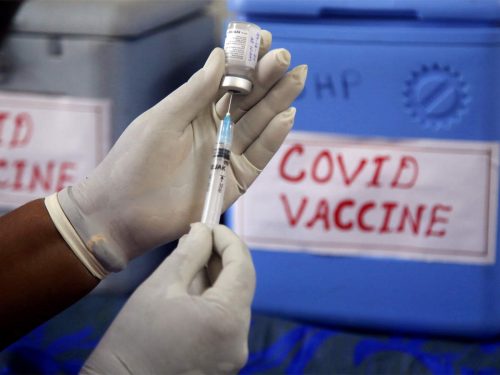ASHA workers, who have to travel long distances in difficult terrain and unpredictable weather to reach the villages they are allotted, say they have very little support from the government.
Kavitha, a 49-year-old mother of two, wakes up at 5.30 am every day and starts her daily household chores, which include cleaning the house and preparing breakfast and lunch for her family. After that, she gets ready and walks to her work. Kavitha is an ASHA (Accredited Social Health Activist) who lives in the small village of Valpady in Dakshina Kannada. Her responsibilities include attending to and checking the well-being of families in the many villages allotted to her.
Many of the hamlets she attends to are very remote with no access by vehicle and the only way to reach it is by foot. Hekal, home to the Malekudiya tribal community, is one such hamlet. Kavitha has to walk around 20 km in the hilly terrain of the Western Ghats to reach Hekal. On the way, she has to cross three streams and face the risk of being attacked by wild animals, including elephants and tigers. Whenever she spots an elephant, she has to quietly walk in the cover of bushes or take a different, longer route.
After finally reaching the hamlet, Kavitha speaks to each family and checks for any symptoms of COVID-19 before moving to the next house. This too is a tough task – because the houses are spread out and she has to travel long distances within the area to reach all the families. In case any person shows COVID-19 symptoms, she notes it down and advises them to remain under quarantine and avoid contact with others. She also ensures that pregnant women are healthy and takes them to the doctor for regular appointments. After completing her work, she again treks the 20 km back home in the evening.
Kavitha’s journey is all the more arduous in the monsoon. She says, “When it is the rainy season, my task becomes much harder. The streams turn into rivers and bridges are completely submerged. So I’ll have to take a much longer route.”

ASHA Worker Kavitha
Like Kavitha, many ASHA workers have to go to great lengths to do their job in some of the districts in Karnataka, including Kodagu, Chikkamagaluru, Shivamogga and parts of Hassan, where the terrain is hilly and the population sparse.
Daily travails
Gowri*, another ASHA worker from Chikkamagaluru, travels about 14 km daily to reach the villages of Hennangi and Gaddemane. There are approximately 75 houses in Hennangi and 25 in Gaddemane. In both villages, Gowri says she has to walk at least 10 minutes on average to go from one house to the next. “In both these places, the houses are located in the middle of fields and the properties are fenced off, in many cases with electric fences. So, I have to walk a long way to get to each house,” she says.
She says that there is no other option except walking from house to house as there is no bus facility. “These are very remote areas and there is no bus facility. Private transport is not of much use as they drop us only till the main road. Moreover, they charge Rs 400 to go that far. If I take private vehicles multiple times, I’ll end up spending all my earnings on travel itself so it’s not really an option,” Gowri adds.
The travel conditions are similar for Poornima (51), who works in Kodagu. She has to walk 7 km to her area of work. In the current monsoon season, she says it is extremely difficult and at times next to impossible to even step out of her house, let alone walk to work due to the rains. Sometimes when travelling by foot is difficult, Poornima’s husband, a retired soldier, drops and picks her up from work. She leaves at 9 am and returns only by evening. Because of the pandemic, she avoids eating anywhere except at home, meaning she has to skip lunch every day.
Poornima has to keep tabs on 770 people and ensure that all of them are healthy. Her workload has increased many times since the pandemic began as the entire responsibility of identifying people with symptoms, getting them tested and sending them to quarantine has rested on her. This also resulted in Poornima facing verbal abuse from people.
“Since the pandemic began, our already difficult job has become all the more difficult; we were given the responsibility of identifying people with symptoms and getting them tested. I have to say, this was hell. People would get angry when we mention testing, I had to hear so many abuses. This only got worse if someone tested positive. I had to personally go and make sure transportation was arranged to take them to the quarantine centre. They would call me and shout over the phone saying it is because of me that they are locked up. But what do we do? We think it’s our duty and just go through it,” Poornima says.
Poornima adds that this is more or less the plight of all 475 ASHA workers in Kodagu.
Vaccination
Since vaccination began, ASHA workers have also been tasked with getting people vaccinated. All ASHA workers that TNM spoke to said that it was a very difficult task to make people understand the importance of taking the vaccine. In spite of that, they have played a key role in driving the vaccination programme in these areas, tirelessly travelling to the remote settlements and convincing people to take the vaccine.
“Initially, the vaccine hesitancy was so bad that when we called 100 people to take the vaccine hardly eight would show up. Each one of us had to visit every single house and convince people. Many were convinced only after I assured them that I’ve taken both doses of the vaccine. Now of the 350 people who were eligible under the areas I look after, 200 have received at least one dose,” Poornima says.
When asked if they received any help from doctors and nurses in their Primary Health Centres (PHCs) in convincing people, Poornima responds, “Firstly, doctors and nurses are present only in the PHCs and there is a huge shortage of staff. I don’t say this to brag, but the reality is that I and most other ASHAs go alone and do this task of convincing people. It wouldn’t be wrong to say that most of the residents wouldn’t have taken the vaccine if we hadn’t convinced them and constantly followed up. Also, it is we who finally call or go inform physically that vaccines will be given on this or that date.”
Gowri, too, had to go from house to house to inform people about vaccination drive dates and convince them to get inoculated. A total of 130 people have been vaccinated, which is half the eligible candidates that Gowri is deputed to attend. She also has had her share of difficulties trying to get people vaccinated.
“Though not all areas, the doctor visited a few to conduct vaccination drives. However, people were scared. Once they get the news of the doctor coming, they’d either leave their homes or lock themselves in and not open the door despite several requests. It was only after I went alone and sat with each family and convinced them that they finally came to get the vaccine,” she says.
Kavitha’s experience was also similar as she had to go and convince each family to get vaccinated. She says that out of the 980 people that she is deputed to attend, around 400 are eligible out of which around 200 people have been inoculated with at least the first dose.
Other ASHA workers TNM spoke to also narrated similar experiences and said that most residents in the villages and remote settlements of the Western Ghat districts took the vaccine only after the ASHA workers painstakingly convinced each family. It is evident that the biggest role in getting many of these communities vaccinated was played by the ASHA workers.
Other difficulties
The ASHA workers say that people are finally understanding the necessity of getting the vaccine, but there aren’t enough doses available. Many workers also told TNM that people get angry at them about the non-availability of vaccines.
“Initially there were many vaccine doses available but people were reluctant to come. Now people want the vaccine but there aren’t enough doses. Many in my area call me to ask when they can get vaccinated. We also don’t know when the vaccines will arrive and when I tell them that, they get irritated and start shouting at me as if we’re the ones responsible to procure the vaccines,” Kavitha says.
She adds, “Whether it is the issue of testing, quarantine or vaccination, we ASHA workers are on the receiving end of everything. People take out all their anger against us.”
Protective equipment and sanitiser
When TNM asked the ASHA workers if they were being provided masks and sanitisers, all of them reported that they had received no more than two N95 masks from their respective PHCs from the beginning of 2021. Some were given two more additional masks from their panchayats but other times they have had to spend money and buy on their own.
“We were given two masks and half a litre of sanitiser from the PHC at the beginning of the year and the panchayat also gave me two masks. Beyond that, we have had to purchase masks and sanitiser ourselves,” says Kavitha.
No support from government
The ASHA workers say the government does not do enough to support them in spite of their hard work. Kavitha explains, “Despite working so hard, we barely make about Rs 7,000 a month, and out of that, we have to spend on travel, masks, sanitiser, etc. Sometimes when I see the money I get for such laborious work, I question the viability of this job. However, I still continue as this job gives me the happiness of helping so many people.”
When asked what would help ease their situation, all of them responded that a travel allowance would be useful.
“Travelling in private vehicles is very expensive in our parts. Even if we use our own vehicles, the fuel price is very high. So, if the government provides us some allowance for travel, that would be helpful,” says Poornima.
However, this is not beneficial for ASHA workers like Kavitha because most of the places she has to visit don’t have any kind of transport facilities. Even if she did own a personal vehicle, she would only be able to cover part of her route. She says that a travel allowance wouldn’t help her in a very big way, instead an increase in pay would make her work worthwhile.
“Many times, when I can’t step out of the house due to rain I don’t make that much money. The only thing that will be beneficial for those like me is a steady salary and a pay hike to around Rs 12,000,” Kavitha says.
Speaking to TNM, D Nagalakshmi, the state secretary of the Karnataka Rajya Samyukta ASHA Karyakarteyara Sangha, which is affiliated to the All India United Trade Union Centre (AIUTUC), says, “Initially when ASHA work started, it was supposed to be just for a few hours daily. Later, it became more than eight hours. The workers have to do surveys year round, take care of mother and children’s health, etc. Since the pandemic began, the work has increased drastically, starting from identifying people with COVID-19 symptoms, getting them tested, getting them quarantined, following up to check if they are adhering to the quarantine, tracing primary and secondary contacts. Now, additionally they have to inform people about vaccination and motivate them to get the vaccine. We see many of them spending over 12 hours on the job daily.”
She further says, “In all these Western Ghat districts, if any government healthcare benefit is reaching the people, it is only because of ASHA workers. They walk several kilometres in the most interior parts of these districts and serve people. We demand that they be given Rs 12,000 as salary, which, by the way, is the minimum wage declared by the government.”
In addition to this, she points out that government nurses receive a remote area allowance when they have to travel far. She asks, “When this is applicable to nurses, why is it not applicable to ASHA workers?”
“We demand that this travel allowance be given to ASHA workers in Western Ghat districts. Also, the government must ensure that the workers are provided adequate protective gear to do their work. The workers risk their lives for the job, so how can the government not ensure even this minimum requirement?” she adds.





































